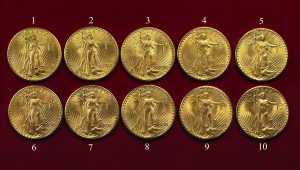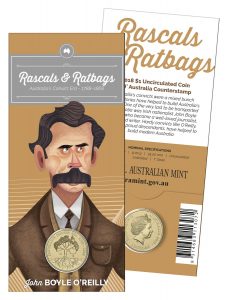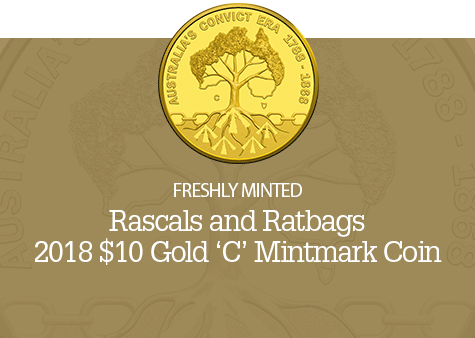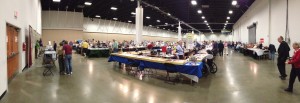Weekly World Numismatic News for October 10, 2021
 The weekly numismatic news report is late for the same reason the U.S. Mint cannot run an ordering system. It seems that the dangers to online systems are growing.
The weekly numismatic news report is late for the same reason the U.S. Mint cannot run an ordering system. It seems that the dangers to online systems are growing.
Every week, I am receiving reports from collectors being scammed by Chinese counterfeiters. People are providing pointers to websites and other sellers that are pushing counterfeit coins. The most common coin is the American Silver Eagle.
Last week, the parent company of HiBid, one of the largest online auction platform after eBay, was struck with a ransomeware attack. HiBid was taken down Thursday, September 30 through Monday, October 4. To add insult to injury, HiBid crashed again on Sunday, October 10 because bidders overloaded their systems.
As I am looking for new business opportunities, several eBay sellers are also looking for alternate selling venues. They are complaining about how eBay has handled the conversion to charging sales tax collection. New programs do not include the small sellers. Although eBay has always preferred high-volume sellers, now they are adding programs to benefit those that sell high-value items. And some sellers are reporting driven crazy by eBay’s new payment system.
With all this happening, then how does one buy online? I have been buying from eBay. It has been a convenient way to find interesting out-of-print numismatic books and tokens from New York. My other buying venues have been the U.S. Mint, the Royal Mint, and Apmex.
Maybe it’s time to look for other purchase venues.
 → Read more at news.sky.com
→ Read more at news.sky.com
 → Read more at cphpost.dk
→ Read more at cphpost.dk
 → Read more at kentonline.co.uk
→ Read more at kentonline.co.uk
Weekly World Numismatic News for May 27, 2018

Saudi Arabia to replace the one-riyal note with coins (Image courtesy of Asharq Al-Awsat)
SAMA made the announcement as part of their introduction of new coin designs using modern techniques in coin manufacturing.
Under their transition plan, SAMA will allow the SR1 paper note to circulate alongside the new coin as the notes will be withdrawn from circulation. When the coins become available, the banks will be ordered to replace the SR1 note with a coin based on an availability formula that will be provided when the coins are ready for circulation.
According to Society for Worldwide Interbank Financial Telecommunication (SWIFT), the company that runs the network that enables the world’s financial institutions to security send financial transactions to each other, the United States dollar makes up 40.86-percent of every transaction in the world (as of February 2017). The United States Gross Domestic Product (GDP), the measure of an economy’s output, is over $19 trillion (in 2017 according to the International Monetary Fund) more than any country or trading cooperative (such as the European Union). But the United States is the only country ranked in the Top 10 of either of these lists to continue to produce its unit currency in paper form.
For a country that is supposed to be a leader, it looks like the United States has fallen behind the rest of the world. It is time to eliminate the one-dollar Federal Reserve Note.
And now the news…
A new £1 coin could actually end up earning you hundreds thanks to a Royal Mint 'error'. Three examples of the error have already been seen by ChangeChecker – and they are selling for more than £200.  → Read more at bristolpost.co.uk
→ Read more at bristolpost.co.uk
Prosecutors won’t pursue charges against a drummer accused of stealing rare coins and a passport from famed New Orleans musician Fats Domino.  → Read more at pagesix.com
→ Read more at pagesix.com
The sifting project, which has operated since 2004 in the Emek Tzurim National Park, aims to salvage religious and historical artifacts from the rubble, as well as to educate the public about the veracity of Jewish history on the Mount.  → Read more at jns.org
→ Read more at jns.org
Aaron Judge and Michael Conforto are two of the young stars that New York baseball fans have been buzzing about the past two years. Now fans of the Yankees and Mets outfielders can now get the star…  → Read more at nysportsday.com
→ Read more at nysportsday.com
2018 Baseball Treasure MLB Coins checklist, release date, silver and gold coin info and all you need to know about the officially licensed set of baseball coins.  → Read more at beckett.com
→ Read more at beckett.com
The much-ballyhooed summit between the United States and North Korea met its end Thursday. The cancellation, for now, stamps out the prospects for peace, yet does nothing to stop the snazzy coins featuring Donald Trump and Kim Jong Un in front of patriotic backdrops surrounded by olive branches  → Read more at cnn.com
→ Read more at cnn.com
The Saudi Arabian Monetary Authority (SAMA) will start withdrawing SR1 banknotes from the market from Thursday, SAMA has said. In a statement, SAMA announced issuing its sixth edition, which was developed during the reign of the Custodian of the Two  → Read more at aawsat.com
→ Read more at aawsat.com
Trumping a Challenge Coin
The challenge coin in question was created by the White House Communications Agency (WHCA) for the now-canceled summit between President Donald Trump and North Korean Supreme Leader Kim Jung-Un. The partisan nature of our national politics and now the status of the summit has created a false narrative about the challenge coins that do not do the hobby any favors.
To set the record straight, a challenge coin is not a coin. A coin is a disk, usually made from metal, formed into a disk of standardized weight and stamped with a standard design to enable it to circulate as money authorized by a government body. In the United States, only the U.S. Mint is authorized to manufacture coins.
Challenge coins are medals with an organization or event logo or emblem that are part of a tradition to honor service. Challenge coins are part of a military tradition that started during World War I when Ivy League students went to war and created these coins as an act of camaraderie.
According to legend, a World War I pilot was shot down behind enemy lines and captured by German soldiers. Since the pilot kept the coin in a pouch around his neck, the Germans did not confiscate his coin. That evening, the pilot was kept in a French-German town that was bombarded in the evening by allied forces. The pilot escaped during the bombing. During the next day, the pilot came upon a French military unit who was told to watch for German soldiers posing as citizens. To prevent from being arrested and executed by the French soldiers, the pilot showed them his challenge coin. One of the soldiers recognized the insignia and delayed the execution until they were able to verify the pilot’s identity. Once the story spread, a tradition was born!
As a show of camaraderie, units began to issue specially designed coins to each other. The challenge came when members drew their challenge coin and slapped it on the table, the rest of the members with them must produce their challenge coin. If someone does not have their challenge coin, that person must buy a round of drinks for the group. The challenge is used as a morale builder amongst the group.
Challenge coins regained popularity around 1991 with the veterans and descendants of the Pacific Fleet honoring the service of those who survived and did not survive on the 50th anniversary of the attack on Pearl Harbor. They saw wider acceptance, especially outside of the military, following the attacks on September 11, 2001. As retired military members began to lead security-related civilian agencies, the use of challenge coins grew beyond the military.
The challenge coin in question is the product of a military organization.
The WHCA was founded in 1942 as the White House Signal Corps to provide communications for the White House. It is their job to make sure that whenever and wherever the presidents needs to communicate with the government or foreign leaders that he can do so and securely if needed. It is under the jurisdiction of the Defense Information Systems Agency (DISA).
This is not the same agency as the White House Communications Director. That position was vacated by Hope Hicks in March 2018. White House Press Secretary Sarah Huckabee Sanders would report directly to the Communications Director, not the WHCA.
Since 2003, WHCA has created challenge coins for nearly all overseas travel by the president. Only the secret travels to war zones when the president made surprised visits to U.S. troops were not honored with a challenge coin.
In this case, the challenge coin that made the news was made for the members of the advance team whose job it is to make all of the arrangements for a safe and successful trip.
The U.S. Mint does not produce these challenge coins. An approved manufacturer is contracted to design and strike the medals. That contractor works with the WHCA to create the design. After the design is approved, a limited number of medals are produced.
Everyone who is part of the mission receives a challenge coin. Some journalists who fly on Air Force One may receive challenge coins, most do not accept them. Former NBC News Anchor Brian Williams admitted to collecting Challenge Coins during a broadcast in 2009.
The inventory is separated to make sure that enough challenge coins are available to everyone making the trip and a few who were left behind on support duty. For example, one is probably set aside for Sarah Sanders who does not travel as much. As the first Press Secretary who is a mother with children still at home, she understandably stays nearby to care for them.
The rest are offered for sale in the White House Gift Shop.
The White House Gift Shop (WHGS) is located in the White House and open to anyone able to visit. It is a separate organization from any of the agencies mentioned. If you cannot visit, everything the gift shop offers is available on their website at whitehousegiftshop.com. This includes challenge coins.
Reporters covering the White House spotted the WHCA Challenge Coin in the WHGS, took a picture and used their social media access to report its existence.
Irrespective of the political arguments being made over the subject matter, there is nothing illegal or morally wrong with the challenge coin. Although government funds were used to create the coin, those funds are included as part of the budget passed by Congress. Yes, the WHCA has a budgetary line item for the creation of challenge coins to help with the morale of the military detachment to the White House.
One of the reasons I looked into this issue was to find out who designed the coin. The artist did such a good job that I would recommend that they apply for the Artistic Infusion Program with the U.S. Mint. It is a fantastic representation for those participating as part of the advance team. The artwork and symbolism were really nicely executed. Using the enameled flags in the background leaving the two leaders to stand out without the enameled finish has a strikingly good look.
It is one of the best design I have seen for a challenge coin representing an event.
This challenge coin is no longer for sale in the WHGS. The webpage for the medal was changed to note that a new challenge coin will be designed for the event by the same artist who designed the WHCA challenge coin. The CEO of the WHGS published a note saying that the new challenge coin will be similar to the WHCA challenge coin. If you are interested, you can order one from their website.
The U.S. Mint is not doing its job going after more 1933 Double Eagles

The ten 1933 Saint-Gaudens Double Eagles confiscated by the government from Joan Lanbord, daughter of Israel Switt.
For those who have not read Illegal Tender by David Tripp or Double Eagle by Allison Frankel, aside from both being worth reading, they claim that 25 of these coins were illegally removed from the Philadelphia Mint. Of those 25 coins, nine were confiscated during the 1940s and 1950s by the Secret Service, ten are from the Langbord Hoard stored at the Bullion Depository at Fort Knox, and one is the Farouk-Fenton example which is the subject of the books.
That leaves five left.
During the Pennsylvania Association of Numismatics (PAN) spring show, U.S. Mint Senior Legal Counsel Greg Weinman said that he knows where one is located in the United States, one is in Europe, and a third is somewhere else. The location of the last two is not known.
It can be speculated that the “somewhere else” may be in Egypt. On February 8, 2008, the Moscow News Weekly reported that a version of the coin was found in Egypt in an old box that was owned by the discoverer’s father (web archive link). Although there had been a lot of speculation that coin might not be genuine, there has been no further reports as to the disposition of this coin.
Weinman said that there are no plans to go after the three coins where the U.S. Mint knows their location.
Why?
Following the trial in 2011 with a jury verdict against the Langbords. After the ruling, Assistant U.S. Attorney Jacqueline Romero, the government’s lead attorney in the case, came out with a courthouse statement, “People of the United States of America have been vindicated.”
If the country is to be vindicated and the government has consistency in its argument that the coins are “chattel,” according to Weinman, then it is their legal obligation to have the U.S. Secret Service pursue the three known examples.
Otherwise, it could be said that the government has undergone selective prosecution and has given up its right to the ten in its possession or the five that are still in public hands.
It is these inconsistencies of policies with regard to these coins that could drive collectors away. While most people may never find or own one of these rare coins, what happens to those who might get lucky.
While the 1913 Liberty Head Nickels were not considered chattel because they were never struck for circulation, the government fought the finding of the 1974-D Aluminum cent forcing its return. The circumstances for the striking of both coins are similar but the government has treated each issue differently.
This is not a matter of integrity of the hobby. It is the integrity of the U.S. Mint and their bogus argument of what is or is not something they produced for whatever the reason. The integrity of the U.S. Mint can be questioned when they applied 21st century operating standards to the U.S. Mint of the 1930s in order to convince a “jury of peers,” none of which probably had a numismatic background questioning their ability to be peers, that these coins belonged to the government for it to hold like some almighty savior of us from the depths of fraudulence.
Do you still feel vindicated?
Weekly World Numismatic News for May 20, 2018

A Rascals and Ratbacs Souvenir card with attached coin (Image Courtesy of the Royal Australian Mint)
After the British discovery of Australia in 1770, they initially settled the colony of New South Whales by exiling criminals to the area. Although there were free colonies in Australia, it became known as Britain’s penal colony. Rather than bemoan their sketchy past, especially since they have moved on to become a successful nation, the Royal Australian Mint seems to have embraced their history to have a little fun and promote coins.
Using its yearly roadshow, the Royal Australian Mint kicked off its Rascals and Ratbags Roadshow Reveal at the Mint in the capital city of Canberra to introduced the Rascals and Ratbags coins. These coins celebrate the 230th Anniversary of the arrival of the First Fleet on the island nation and the 150th anniversary of the Hougoumont, the last ship to carry convicts to Australia.
The coin is available in Australia as a four-coin uncirculated mintmark and privy mark set, a $1 (AUD) silver proof with the “C” (Canberra) mintmark, and a one-tenth ounce $10 (AUD) gold proof coin also with the “C” mintmark.
Since these are not colored coins they will not be a subject of their lawsuit with the Royal Canadian Mint.
As part of the celebration, the Royal Australian Mint is traveling with a portable press to allow visitors to strike a special Australia counterstamp in their coins.
It goes to show that rather than dwell on your past problems, fix them and move on. Have a little fun at your own expense. It is certainly better than the arguing that pervades the United States.
And now the news…
That Makes Cents It’s a U.S. Mint.  → Read more at kqed.org
→ Read more at kqed.org
Canberra’s coin enthusiasts head to Royal Australian Mint for special roadshow reveal.  → Read more at canberratimes.com.au
→ Read more at canberratimes.com.au
On March 6, Ghana’s Independence Day, artist Yaw Owusu was crouched on his living room floor, putting the finishing touches on a new piece. Stretching over most of the floor, the work sparked silver and copper as the sun bounced off the carpet of pesewa coins — the country’s least valuable currency and Owusu’s preferred medium.  → Read more at ozy.com
→ Read more at ozy.com
Break out those piggy banks – if you can get your hands on some old Irish punt, you've basically won the lotto. According to The Central Bank's annual report, $270.4 million (€226m) worth of old Irish punts remains unaccounted for.  → Read more at irishcentral.com
→ Read more at irishcentral.com
The Tokyo Metropolitan Police Department has arrested a man on suspicion of selling counterfeit 2020 Tokyo Olympic and Paralympic commemorative coins. Yasuhiro Kotani, 43, was arrested for allegedly violating the trademark law by possessing the imitations in order to sell them.  → Read more at japantimes.co.jp
→ Read more at japantimes.co.jp
Venkatesh Kandula believes in tracing history through coins. The numismatist from Tuni has around 1,800 coins in his kitty, some that are historical rarities. On World Museum Day, Kandula displayed his treasure trove of rare coin collections at Visakha Museum on Friday.  → Read more at thehindu.com
→ Read more at thehindu.com
OUT OF CIRCULATION SOON These are some of the “Flora and Fauna” and “Pilipino” coin series to be demonitized. The Bangko Sentral ng Pilipinas (BSP) announced on Friday the start of the demonetization process  → Read more at newsinfo.inquirer.net
→ Read more at newsinfo.inquirer.net
About negotiating for your collectibles
If you are a collector of anything you know that the price of your collectible is based on both a market valuation and what you are willing to pay. There are a lot of market valuation tools for the numismatic collector. One of the more popular ones is The Coin Dealer Newsletter and associated publications that track market trends.
In 2012, I wrote a two-part series about how coins are priced (see Part I and Part II) where I discussed not only how the coins are priced by the different markets for purchasing coins. Last year I wrote about other venues to buy your coins and then earlier this year I added information about estate auctions. All have their audiences, which expands the buying options.
One important factor I discussed is how to negotiate. In “How Are Coins Priced (Part II),” I wrote about negotiating from the perspective of the collector. At the time, I had just started my collectibles business and did not have the experience from the other side of the negotiation table to understand from their perspective.
I thought about this when I stumbled upon an article in Sports Collectors Digest about negotiating. The author spoke to collectors and dealers about their negotiating styles and conditions for negotiating. While the information about negotiating from the collector’s perspective is not that different than what I originally wrote, the impression from the dealer’s perspective is what I have witnessed.
My experience and the article provides two aspects of negotiating from the dealer’s perspective that I want to highlight here.
First, I want to emphasize the concept of BE POLITE! While most people are polite, there have been times I have wanted to punch a customer in the mouth. While I do not mind a little aggressive negotiating being rude will not make me want to work with you on the price.
Second, understand that you are not only buying an item but selling each collectible comes with a cost. Aside from the cost of the inventory, the dealer has overhead. At a show, the dealer has travel expenses. In a shop, there are expenses with maintaining the store.
Even auctions have expenses. Seller fees can be from 25 to 50-percent of the sale price in many professional auctions. Even eBay charges a final value fee for selling on their site and sometimes there are listing fees. While you might complain about paying more than the postage for the shipping costs, there are labor and material costs for packaging your winning item in addition to the postage.
To highlight the issue, the author spoke with a baseball card dealer who said:
The same thing could be said for numismatics as well.



